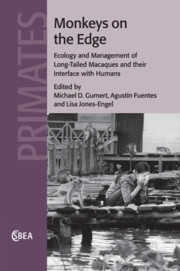Book contents
- Frontmatter
- Contents
- List of contributors
- Foreword
- Preface
- Acknowledgements
- Part I The status and distribution of long-tailed macaques
- Part II The human–macaque interface
- Part III Ethnophoresy of long-tailed macaques
- 8 Macaca fascicularis in Mauritius: Implications for macaque–human interactions and for future research on long-tailed macaques
- 9 The support of conservation programs through the biomedical usage of long-tailed macaques in Mauritius
- 10 Ethnophoresy: The exotic macaques of Ngeaur Island, Republic of Palau
- Part IV Comparisons with rhesus macaques
- Part V Understanding and managing the human–macaque interface
- Index
- References
8 - Macaca fascicularis in Mauritius: Implications for macaque–human interactions and for future research on long-tailed macaques
from Part III - Ethnophoresy of long-tailed macaques
Published online by Cambridge University Press: 16 May 2011
- Frontmatter
- Contents
- List of contributors
- Foreword
- Preface
- Acknowledgements
- Part I The status and distribution of long-tailed macaques
- Part II The human–macaque interface
- Part III Ethnophoresy of long-tailed macaques
- 8 Macaca fascicularis in Mauritius: Implications for macaque–human interactions and for future research on long-tailed macaques
- 9 The support of conservation programs through the biomedical usage of long-tailed macaques in Mauritius
- 10 Ethnophoresy: The exotic macaques of Ngeaur Island, Republic of Palau
- Part IV Comparisons with rhesus macaques
- Part V Understanding and managing the human–macaque interface
- Index
- References
Summary
Introduction
Macaca fascicularis is an extremely adaptable species that is found throughout the continental and insular Southeast Asia (Gumert, Chapter 1). In the sixteenth century, long-tailed macaques were introduced by Portuguese or Dutch sailors from Sumatra or Java into Mauritius where they have readily adapted to flora entirely different from that of Asia (Sussman and Tatterall, 1986; Cheke, 1987; Kondo et al., 1993; Tosi and Coke, 2007; Blancher et al., 2008).
Throughout their range, long-tailed macaques inhabit dense primary canopy forest, riverine and coastal forest, mangrove and nipa swamp, as well as secondary forest, and disturbed habitats (Medway, 1970; Southwick and Cadigan, 1972; Kurland, 1973; Rijksen, 1978; Rodman, 1978a; Fittinghoff and Lindburgh; 1980; Wheatley, 1980; Crockett and Wilson, 1980; Fooden, 1995; van Schaik et al., 1996; Fuentes et al., 2005; Ong and Richerson, 2008). They are found from sea level to 2000m (Rowe, 1996; Supriatna et al., 1996), and are “adaptable opportunists” (MacKinnon and MacKinnon, 1980). For example, Crockett and Wilson (1980) found M. fascicularis in 22 of 25 habitat types surveyed in Sumatra, in contrast to eight of 25 exploited by M. nemestrina.
Long-tailed macaques also are commonly found in habitats disturbed by humans, including urban and agricultural settings. In an early report, Medway (1970) observed that, of all southeast Asian primates, long-tailed macaques consistently and easily utilize secondary forest. Even within their riverine habitat, they seek out naturally disturbed areas. One can expect to see many groups around villages, cultivated fields, and along rivers.
- Type
- Chapter
- Information
- Monkeys on the EdgeEcology and Management of Long-Tailed Macaques and their Interface with Humans, pp. 207 - 235Publisher: Cambridge University PressPrint publication year: 2011
References
- 17
- Cited by



